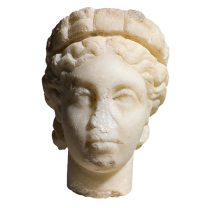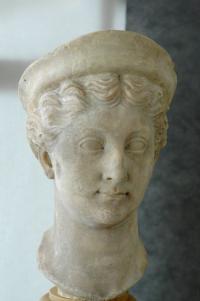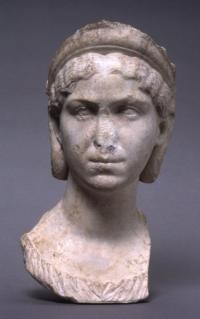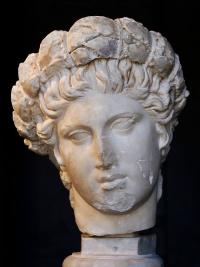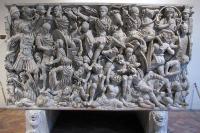Head of a woman wearing a crown
Learn more about the object below
For Roman women, hair had more than just aesthetic potential; it was a status symbol. Elaborate hairdos demonstrated the number and skill of servants at the woman’s disposal. But hair was not always extravagant, as evident in this portrait from Mount Holyoke’s collection. Under her crown, gentle waves sweep back behind the ears and tie in a simple knot at the nape of the neck. This trend, set by the empress Sabina (portrayed at right), signifies the passivity of the Roman woman. Unlike a man’s wild, free-falling hair, hers is quiet and controlled. The figures’ mild expressions, relaxed brows and lips, suggest their calm demeanor.
The condition of many Roman statues reflect serious damage, either from hundreds of years of wear and tear, or from damnatio memoriae, effacement meant to tarnish the memory of the subject. The empress Julia Mamaea, for example, suffered a damnatio memoriae, and her nose was subsequently removed from her portraits. But because Mount Holyoke’s noseless sculpture is a private portrait of an unknown woman, it is unlikely to have been a victim of vandalism. This poses a dilemma for curators and conservators: reconstruct the nose based on assumptions of shape, or leave it damaged but authentic?
Laurel was commonly associated with male achievement. Greek and Roman athletes and soldiers wore crowns of laurel to celebrate victory. Women wore wreaths of poppy, wheat, or ivy as symbols of fertility. What, then, is the significance of the laurel crown on Mount Holyoke’s sculpture of a woman? Since gods are often depicted wearing laurel, as illustrated by this portrait of Apollo, the wreath is also linked to religious worship. This woman is most likely a priestess, decorated in a laurel as a symbol of sacred rites. Note the row of holes below the crown, that may have held jewels.
Few figural sculptures are admired from behind, and indeed, this portrait of a Roman woman was not designed to be seen from all sides. The hair on the crown of her head is rendered without detail or texture. While the neck support suggests that the figure was freestanding, the flattened back shows that it may come from a sarcophagus. A Roman sarcophagus was often decorated with mythological scenes, portraits, or inscriptions which reveal the personality of its occupant, such as the Grande Ludovisi Sarcophagus illustrated at right. We can only guess what this woman’s story was, but, based on her large scale, the sarcophagus must have been very grand.
Label text by Sylvia Peterson (MHC '12)
Suggested readings:
Burns, Jasper. Great Women of Imperial Rome: Mothers and Wives of the Caesars. Routledge, New York 2007.
Bartman, Elizabeth. Hair and the Artifice of Roman Female Adornment. American Journal of Archaeology Vol. 105, No. 1 (Jan., 2001), pp. 1-25.
Damnatio Memoriae, Julia Mamaea, Livius.org. <http://www.livius.org/da-dd/damnatio/damnatio_memoriae.html>
Flory, Marleen B. The Symbolism of Laurel in Cameo Portraits of Livia. Memoirs of the American Academy in Rome, Vol. 40, (1995), pp. 43-68.
Sorabella, Jean. “A Roman Sarcophagus and Its Patron.” Metropolitan Museum Journal, Vol. 36, (2001), pp. 67-81


